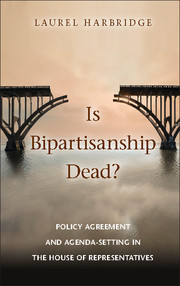Book contents
- Frontmatter
- Contents
- List of figures and tables
- Acknowledgments
- 1 Introduction
- 2 A Puzzle of Declining Bipartisanship
- 3 Strategic Partisan Agenda-Setting
- 4 Agenda-Setting and the Decline of Bipartisan Cooperation
- 5 Variation in Strategic Partisan Agenda-Setting
- 6 Strategic Partisan Agenda-Setting Across Policy Areas
- 7 District Responsiveness and Member-Party Relationships
- 8 The Past, Present, and Future of Bipartisanship
- Appendix
- References
- Index
2 - A Puzzle of Declining Bipartisanship
Published online by Cambridge University Press: 05 March 2015
- Frontmatter
- Contents
- List of figures and tables
- Acknowledgments
- 1 Introduction
- 2 A Puzzle of Declining Bipartisanship
- 3 Strategic Partisan Agenda-Setting
- 4 Agenda-Setting and the Decline of Bipartisan Cooperation
- 5 Variation in Strategic Partisan Agenda-Setting
- 6 Strategic Partisan Agenda-Setting Across Policy Areas
- 7 District Responsiveness and Member-Party Relationships
- 8 The Past, Present, and Future of Bipartisanship
- Appendix
- References
- Index
Summary
Popular belief holds that bipartisan policy agreement in the House has declined dramatically since the 1970s. How accurate is this depiction? No one who follows politics should be surprised to find that the prevalence of party unity in House voting has increased, that bipartisan patterns of voting have declined, and that the resulting estimates of legislator ideology show evidence of increased polarization. As noted in the introductory chapter, estimates of legislator ideology show increasing differences between members of the two parties, indicating that polarization has nearly doubled between 1973 and 2004. But while vote-based measures reveal many insights about partisan conflict, they are not the only way to assess cross-party agreement on policy. As this chapter demonstrates, an alternative measure of bipartisan coalitions based on bill cosponsorship behavior shows much greater stability in bipartisan agreement. Declining bipartisanship in roll call votes over time, despite continuing bipartisanship in cosponsorship coalitions, creates a puzzle. The lasting evidence of bipartisanship in cosponsorship coalitions over this period should caution us against assuming that members of Congress are so polarized that there is no common ground left between the two parties by the 2000s.
This chapter begins with a brief discussion of the concept of bipartisanship that will pave the way for its primary aims, which are to justify the research design of this book and to dig in to the first empirical analyses. The research design leverages roll call votes in conjunction with bill cosponsorship coalitions to better understand the underlying degree of common ground between House members. It also highlights the weaknesses of traditional roll call vote-based measures for understanding bipartisan agreement. The empirical analyses presented in this chapter compare the trends in bipartisanship in voting and cosponsorship coalitions over the period 1973–2004.
Information
- Type
- Chapter
- Information
- Is Bipartisanship Dead?Policy Agreement and Agenda-Setting in the House of Representatives, pp. 18 - 41Publisher: Cambridge University PressPrint publication year: 2015
